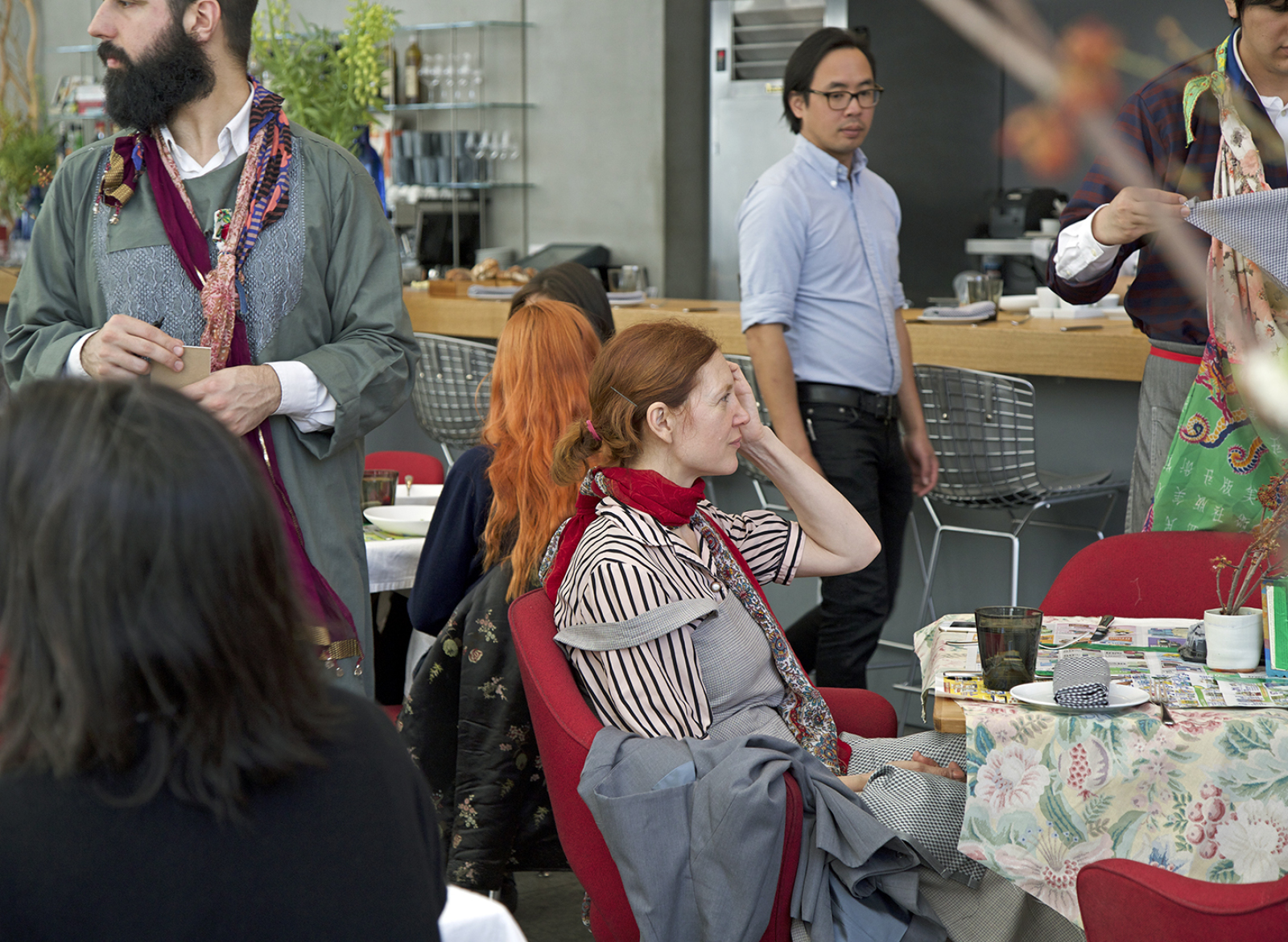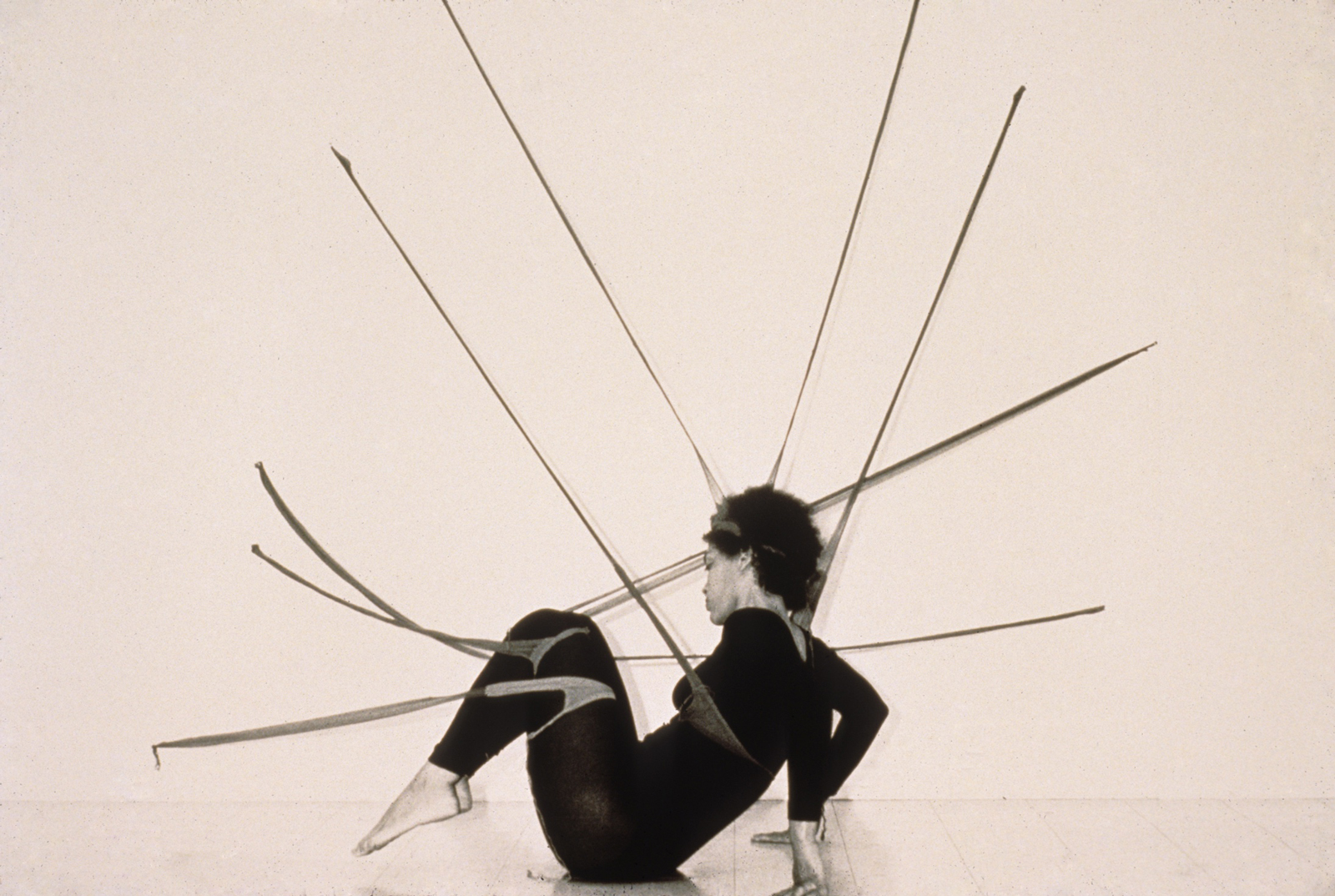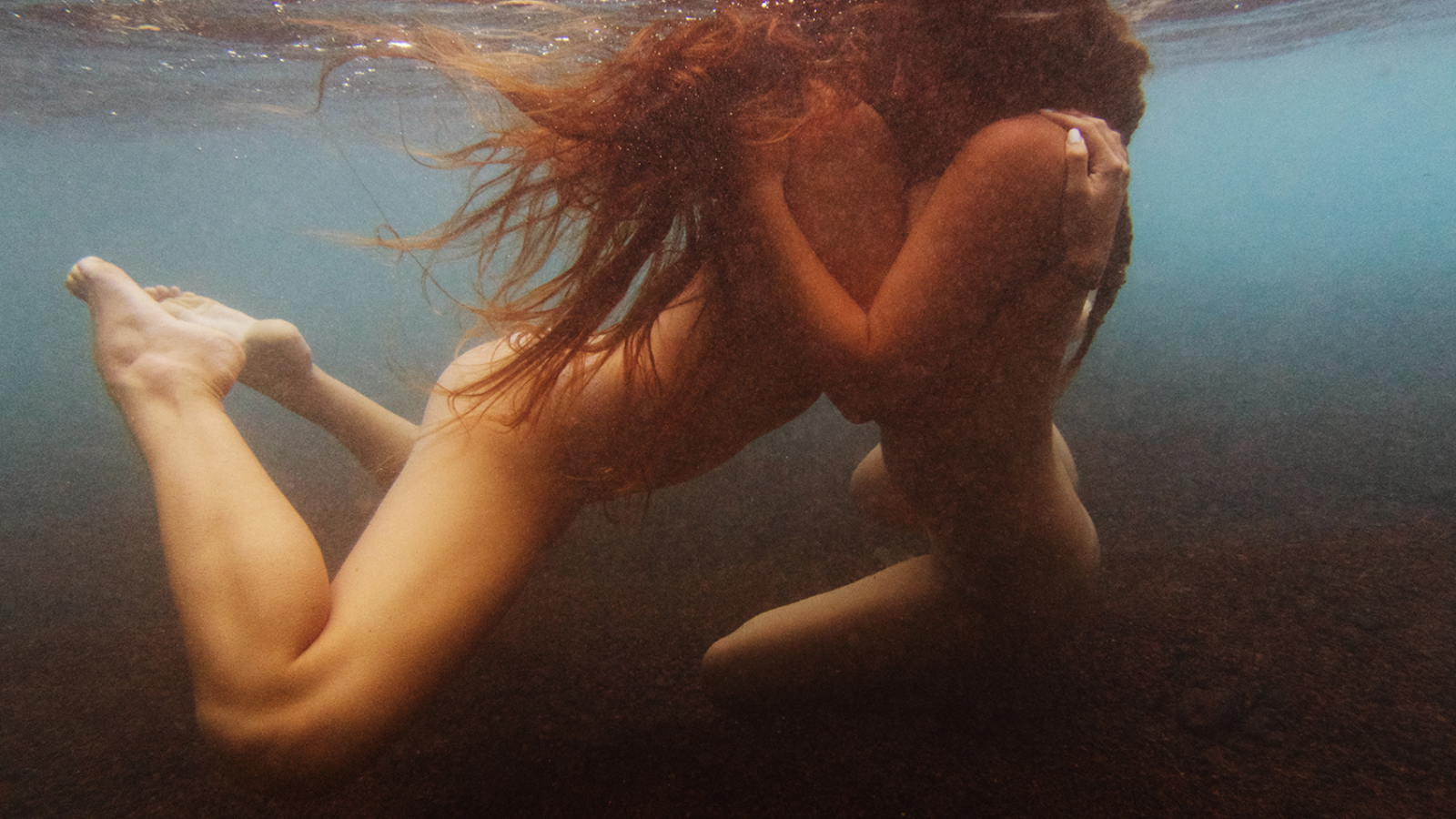Interview: Havana Laffitte
Photo: Olimpia Dior
Run Restaurant is where a woman known as a designer reveals herself as an artist by creating a restaurant. It was so in the ‘90s at Alleged Gallery in Soho, and it is once again in a new way at the Whitney. Havana Laffitte has the New York art world inscribed deep in her DNA her RNA, her mind, body and soul. She is also a veteran of the New York fashion world, and she’s smart and wise and so we couldn’t think of anyone better to sit down with Susan and find out what the experience of Run Restaurant was like for her. In the course of the conversation, they discussed the old restaurant, the experience of creating the new restaurant, the precursors to Run, and the experience of being artists in New York. They also spoke honestly about motherhood in a way that any mom working in a creative field will not want to miss.
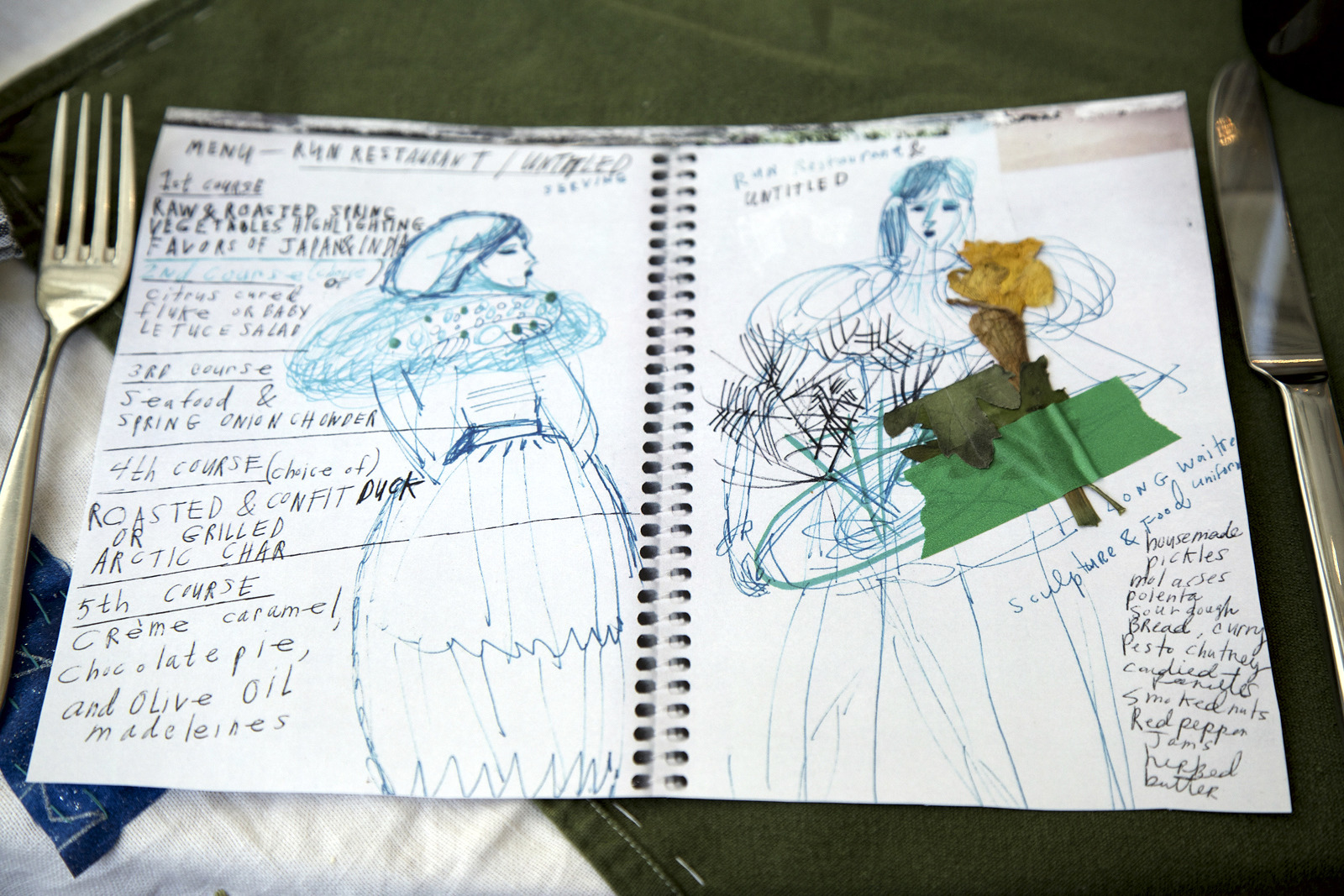
HL: You, You’re energy and your work and who you are embodies the sense of community and humility.
SC: The community aspect is really important.
HL: And anyone who is getting involved with you I would hope would really respect that. What I found so lovely about the experience is it’s so special what you’re doing and important but the ego is set aside and there is this overarching intention of building some type of community and emotional human connection that goes beyond the experience of a restaurant.
SC: I hope so. That’s great for me to hear that. I felt along that way that [the Whitney team] were so organized — and so am I — but we have different ways and styles, so the whole time I had to keep reminding myself, because a lot of anxiety would come up to merge how I do things, how they do things. I realized that their intensity is because they care so much and that helped me to appreciate them so much. The process has always been the most beautiful part for me. That’s what I’ve been working on my whole life: how to find more and more peaceful ways of making work. Last night the waitstaff said, “Wow, everyone’s even more relaxed than last night,” and I realized I must have been more relaxed. I sat at every table for long periods of time.
HL: It was really interesting. I always love being at a mixed table.
SC: Me too.
HL: I really appreciate the opportunity to have conversations with people whose paths I may not come across, so the lunch was very interesting because it was a press event. I was seated with this woman who was a food influencer, which I wasn’t really sure what that meant, but she didn’t really know a lot about you. She didn’t really know your background.
SC: That’s really common, too, which I like.
HL: It was so fascinating because I thought everyone who would come to Run restaurant would come because they know you. You have a history. And then compared to the evening where it wasn’t just people who came for the press but people who really sought out to be able to participate and bought a ticket.
SC: You were next to Knight [Landesman of Art Forum], the little I know him I love to talk to him.
HL: He’s amazing. He said something to me that I wanted to share with you. He said, “We’ve all known about Susan for so long, and we’ve all appreciated her work. It’s so nice to sit here right now and see how the art community has come to her after all these years.” I wanted to ask you, do you feel that after all these years?
SC: It’s interesting because I feel on one side, they would always call and do some little thing, you know. It’s like you said, they acknowledge in some sense, but I felt that last night there were some people there that were with me from the beginning At the table where my father and cousin were seated was Jerry Saltz. I remember him writing on my work in the ‘90s, so it’s not like he just stepped up. He’s been a strong supporter for so long. And then a few tables over was Barbara Moore who I’m doing a lecture with as part of this Whitney program on June 6th. She gave all her archives to the Whitney, and she said she has a whole file on me because she said she kept every single thing I ever gave her. She started collecting my books in the 90s, and she was my main mentor. I would visit her. I would sit and study with verbally, ask her questions about the Bauhaus movement, and Fluxus. I wanted to know everything about Fluxus. And I could learn from a living person, so we developed this friendship.
She was wearing a RUN kimono she had bought from me in the 90’s. I had never considered everyone as stepping up now because those are the people who have always supported me. But of course, especially working with Bridget [Donahue] — it’s the first time I have a real dealer — so she’s really helped introduce my work again and in bigger formats. I remember two years ago when I did a solo show and she said everyone asked “What has she been doing,” and Bridget said, “She’s just been working. Nothing’s changed she’s just quietly working and making, showing in other countries. I feel she helped reintroduce in a way that just clicked. She just got it. I feel so blessed and so thankful that it seems like all of these years of working this is the right time to share it. I’m ready for that because I think energywise, it takes a lot, and like most artists the making is the great part, but the presenting is a whole other part of it, and you have to be really up for it, it’s like being an athlete and it takes so much out of you. But right now feels like the right time and I’m totally ready for it.
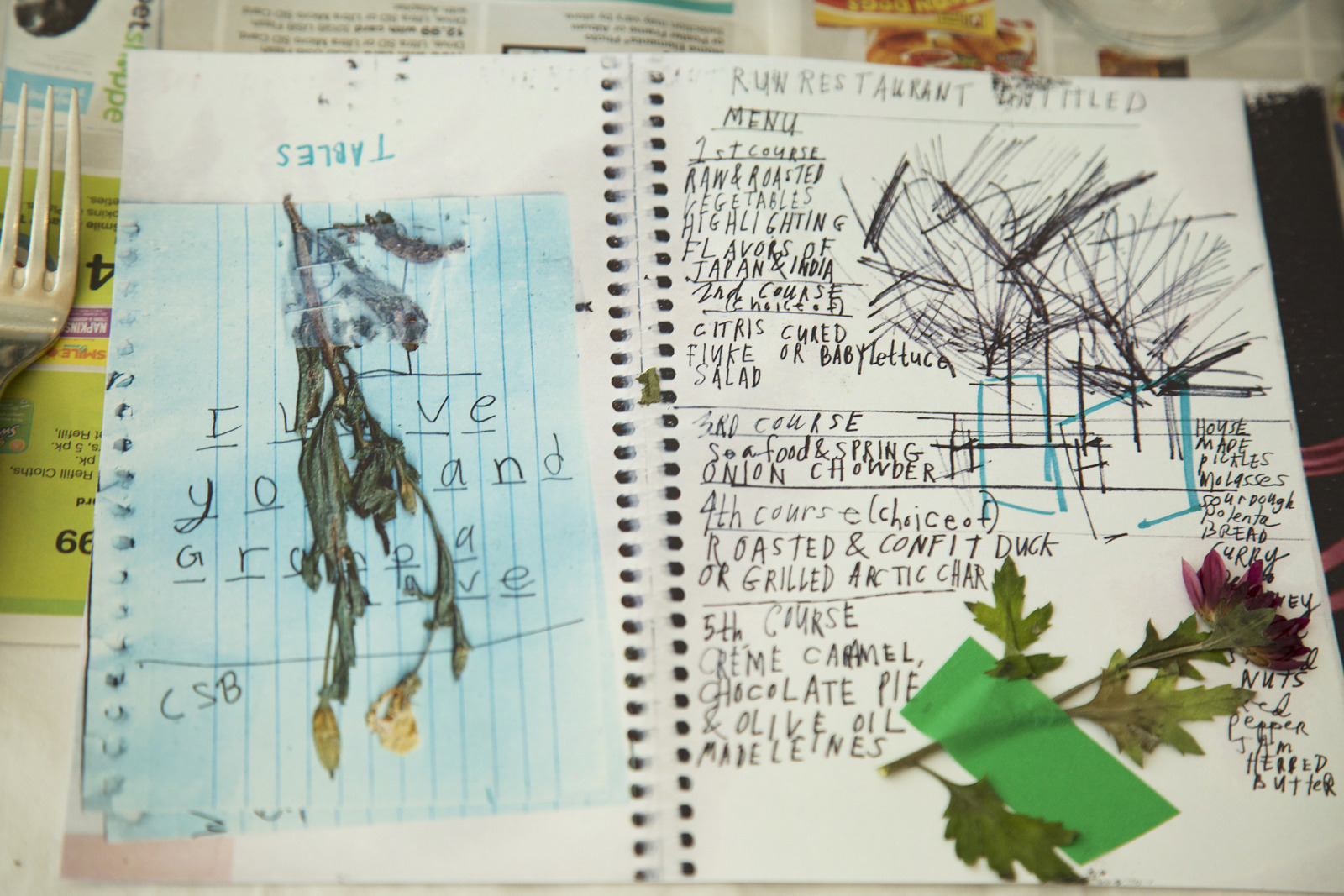
HL: How is the Run restaurant at the Whitney different from the one at Alleged Gallery. What are the most notable differences do you feel?
SC: I’m not cooking this time. I’m so hands off on all of the kitchen and the food and that is very very different. They called me in July. I was in London and I started the next day writing recipes, going to farms, researching, cooking all the time. Every minute of my life was my daughter and I discussing, experimenting: what flavors could be mixed with what and what countries. I met with ( chef) Mike Anthony and kept presenting my ideas until the last meeting when he introduced me to Suzanne [Cupps] . He said, “I’m stepping away from Untitled [the Whitney’s restaurant] and Suzanne’s going to do the last part.” Which was completely unexpected. And then I presented to Suzanne all of my final writings and notes and concepts from where we started and she got it. And then I realized what a master she is. I was blown away about how she took in everything on the menu that came in the end. It’s exactly to a tee everything I wanted. I can’t believe what a genius she is and now I see why she has that position. She is very special. When I was telling her my ideas, she got it. We were so in tune. That seemed like magic and then I could let go of the fact that to present it on this scale, I had to completely let go of the whole hands-on aspect. It was really a big shift for me.
When I would have a lot of anxiety about how this was going to all happen. My mom kept reminding me of the simplicity. The simplicity was the beauty. Because I would get confused. Am I still me in this big environment? My whole idea was taking our home and transporting it there. The simplicity of what we have here. So I had to remind myself of that and not get lost.
HL: I feel like your daughter was a huge influence. With the first one ( at Alleged) she was maybe not around yet. I haven’t met your daughter, but I could feel her presence so much.
SC: She’s made everything with me. And that was a big issue because we had to talk and fight for a long time about why is everything that she made and we made together going out of the house to this other place that everyone’s going to touch. What if they broke things? But she knows that this is my job, and it’s hard for her a lot of the time. It was all based on our home life and how as an 8-year-old can you take that in and be ok with it? Because she wanted to go there so much.
HL: She was hesitant to share this very personal intimate aspect of what you create together..
SC: We had big fights about it all the time to the point where that was most of my nervousness because I said, “Ok then I’ll break my contract and then we don’t do it.” It’s one or the other. There’s no middle ground. But that’s how our life is. She’s very strong and very tough and she’s so involved but yet when it becomes business and in public. That’s a thing where there could be controversy, that I work so closely with my daughter, but there’s no other way to do it. I brought her up by myself, so and I’ve made a clear choice that I was not going to give up being an artist. So she just grew up in my studio, and it was usually a studio outside of my home and very dirty, so she could go and make a giant mess and get out all her emotions. But then this was a big decision to move my studio home because it helps me more become a better mom. I refuse to let the fact that I’m a mother and a parent by myself to give up my career in any shape or form.
HL: I understand. I have two children, and I’m a single mom.
SC: You are?
HL: I have a 12-year old girl and a 6-and-a-half-year-old boy. The dad is around, but I’m very much the full timer. I expose them to my work selectively because I don’t want them to be completely influenced and I don’t want them to feel pressured to be a part of it. But at the same time, I don’t think they can help. My daughter’s now a photographer.
SC: It’s a very big choice but at what point where do you draw the line because it’s your life and you need to do it. And isn’t it better that they see you living your passion than not? It’s better that it’s real; that we’re talking about it.
HL: My parents were artists, too, and they were really kind of crazy and eccentric. I was exposed to everything. It was rough growing up with so much instability, but at the same time, I’m so grateful that I was exposed to it because that’s what I am right now.
SC: That’s so true. Thanks for saying that. [My daughter] was so mad at me when I bleached my eyebrows. She was like, “You look so weird; you look so bad. My friends don’t even think you’re my mom.” So for a while I actually made my hair look as natural as I could, and then I said, “Just for the Whitney, I just need to be who I am, which is a little bit weird.” And then she was like, “It’s fine.” It’s funny the discussions we have. I know I stick out, but at the same time. Last night I said, “I have to go home, make my daughter’s lunch, get up at 6, get her to school.” But the amazing thing is that life keeps me so on the earth. If it was just art, art, art, I would get so wrapped up in the hype, but that every day being that mom and making the breakfast in the morning, that is the real gift.
HL: I agree. I couldn’t agree more. It’s my anchor and my stability in the chaos of everything. There are certain constants. And obviously, they are always going to be the priority. But those simple moments keep everything grounded.
SC: I miss every event even my own openings. I’m really on the clock most of the time. But that’s kind of awesome too. We prepare dinner together every night.
HL: There are times when I say, “I don’t know how I’m going to do this. It’s impossible”.
SC: That’s how I felt preparing for this. I’m never going to do it. I made the decision that I’m not going to work on the weekends anymore because for years I worked through the weekends with her and it really wasn’t good, and at one point we came to terms with that’s our time. And people will try so hard to get that meeting in on a Saturday or Sunday. Saturday is the day we swim and Sunday we drive up to the farm. It’s amazing how they’re healing you in so many ways that I don’t realize until I step back.
HL: It’s a forced stability that we may not instinctively lean towards as an artist. It’s unconditional love. What a gift. What an incredible, unusual gift.
SC: Also then learning how to share that through your work because you’re learning about that all the time. My work was always personal. I don’t think that’s changed, so now it is showing what’s happening personally. The big thing is being a mom. The ups and downs but there have been years where I asked myself, “Oh my god I should have never been a mom because i’m an artist. I can’t do this and it’s not good for her.” And now I’m past that. All those judgements that come in, “Am I a good mom what am I doing?” And now I’ve just let it go. But I think that’s part of the process too.
HL: We are these very strong willed moms. We have a strong sense of our identity and our need to be creative but we also want to be a mom. A few years ago I was really struggling with this and feeling guilty and a metaphysical astrologer told me “ It’s ok! you’re just a Rainbow Mother”. We really do feel that our work needs to take priority, but it’s not that we’re abandoning. You think you’re supposed to be this Earth Mother, but you’re not, so once you stop feeling guilty and embrace it and are ok with it everything becomes more harmonious.
SC: It’s so true, I recently realized that too.
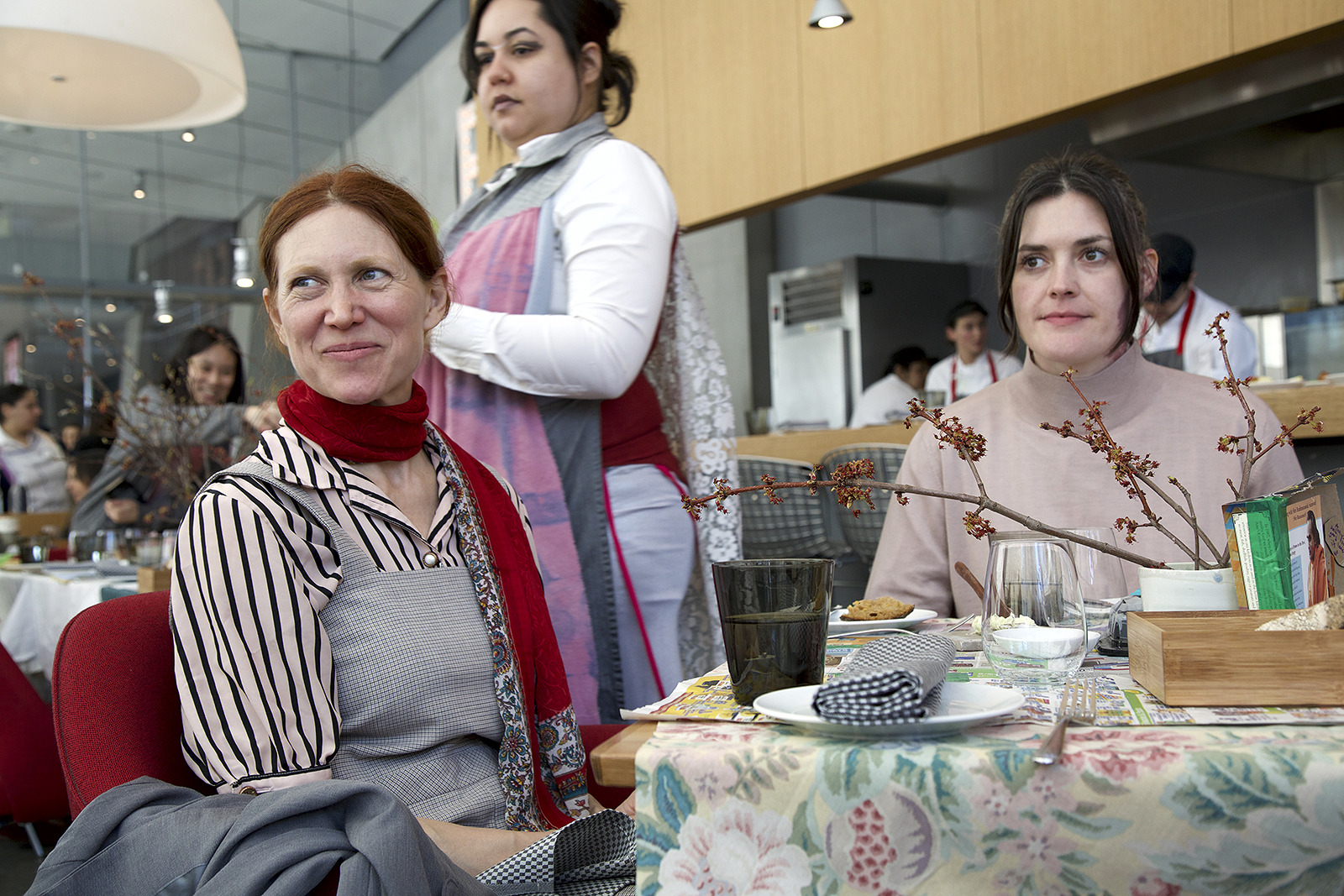
My whole idea was taking our home and transporting it there.
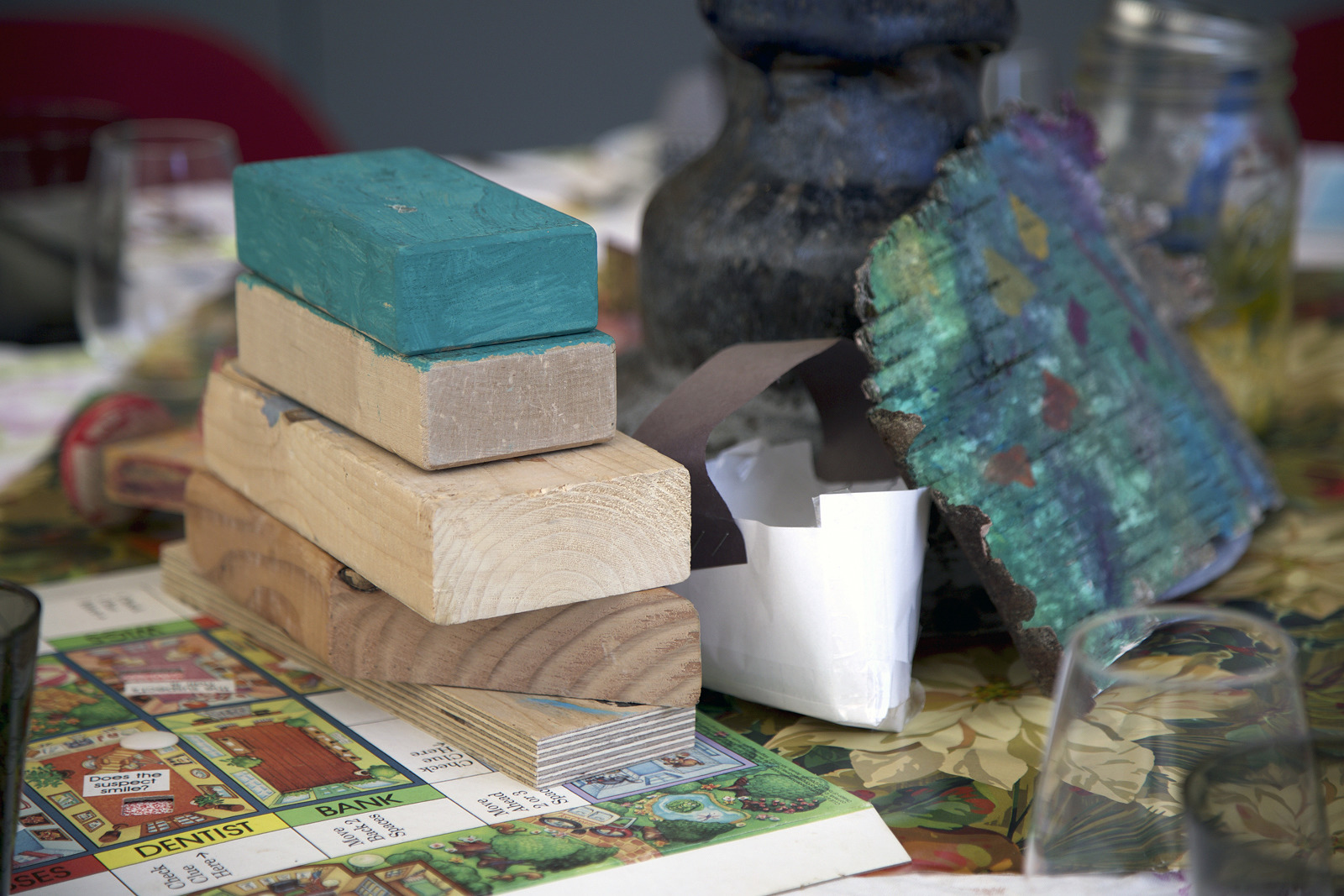
HL: Have you always lived in New York?
SC: For 30 years, which is so long, my god. But I leave so often for shows and I’ve lived in other countries through that period, in Paris and London. I spent a lot of time in Japan. So it’s my base, though. It’s my roots. What I’m seeing more, it’s not really that I’m here because I want New York people to see my work; it’s more that there’s some energy here that this is the source where it’s built. And I see more where it goes out of this source. For some reason I still feel very connected to here. And I don’t ever know what comes next. But so far so good. I’m still happy here with all the changes.
HL: I was born here in the ‘70s and have just been here my whole life, always downtown. My parents and all their friends were those pioneers squatting in lofts in Soho. I was going to ask you if you knew about this restaurant that was in Soho called Food.
SC: Alan, the director of the Whitney, he was at the opening night. He was asking me so many questions and that was one of them: Did I know of ( artist) Gordon Matta Clark’s restaurant Food!! A while ago , as a present, I was given the book Food. It was so beautiful. It was in black and white, and I lived by that book. He was my influence, but just by that book. I was never physically there. Through the pictures and through that book it looked so real and so honest.
HL: Yeah. I used to go to Food a lot when I was a kid.
SC: That’s amazing! Can you tell me what it was like?
HL: Yeah. My uncle is an industrial designer from South America and he was always interested in New York subcultures. When he would come to new york, he would drag me — my parents lived on 3rd avenue near Union Square before it was nice! — down The Bowery every day when he would come on his trips. We’d walk to Prince Street where the restaurant was. It’s the Camper store now or something. We would go to Food and it was this incredible place. I would get a bowl of soup a fresh piece of bread. I had a tray; it was canteen style; you would sit at communal tables. It was a very familiar crowd to me because it was all of these creative people; there was no ego back then, no social media. It was just people looking to convene and commune in a space.
SC: But even the ‘80s and ‘90s was like that, too. We didn’t have social media. It was all word of mouth. We’d make fliers, you’d just drop them off place to place. At an opening you’d go around and tell people.
HL: When I went to your lunch preview the other day, I hadn’t thought about Food in a while, and I was sitting there and I was thinking, “Oh my god this reminds me of Food.”
SC: That is a really big compliment. That’s amazing to hear that from this experience. Not that I wanted it to be that, but I wanted it to come from a true place in that setting. Everyone in that setting is great anyway. It’s a very minimal design, but everyone has incredible hearts from the staff to the chef to her team. That’s what it’s coming from even though we’re in this place that’s changed so much. But it can still be there. My favorite part of the mixed tables is the age differences, so there are people that were there then too that are coming. That’s what I like about the art community. It’s an eclectic mix.
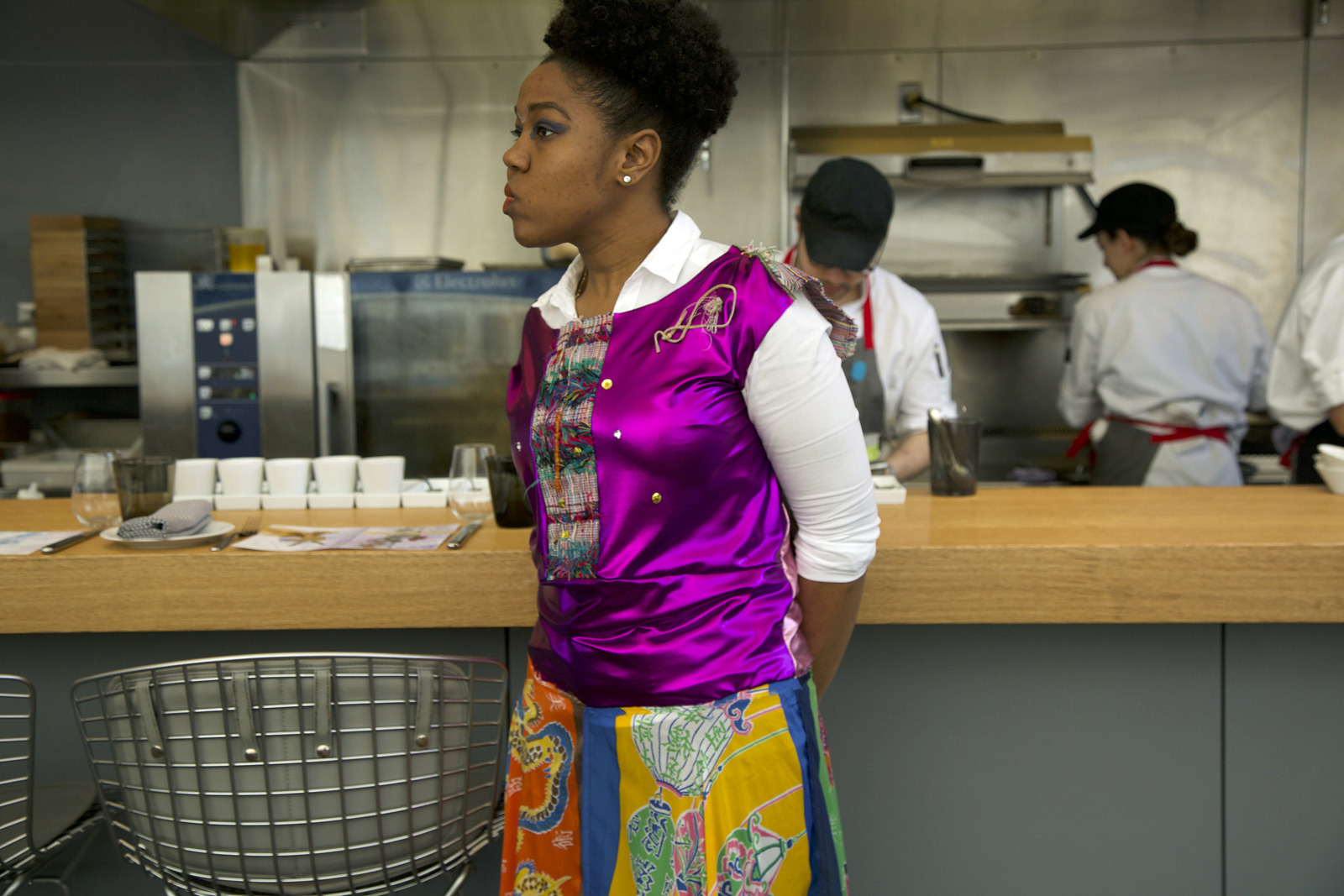
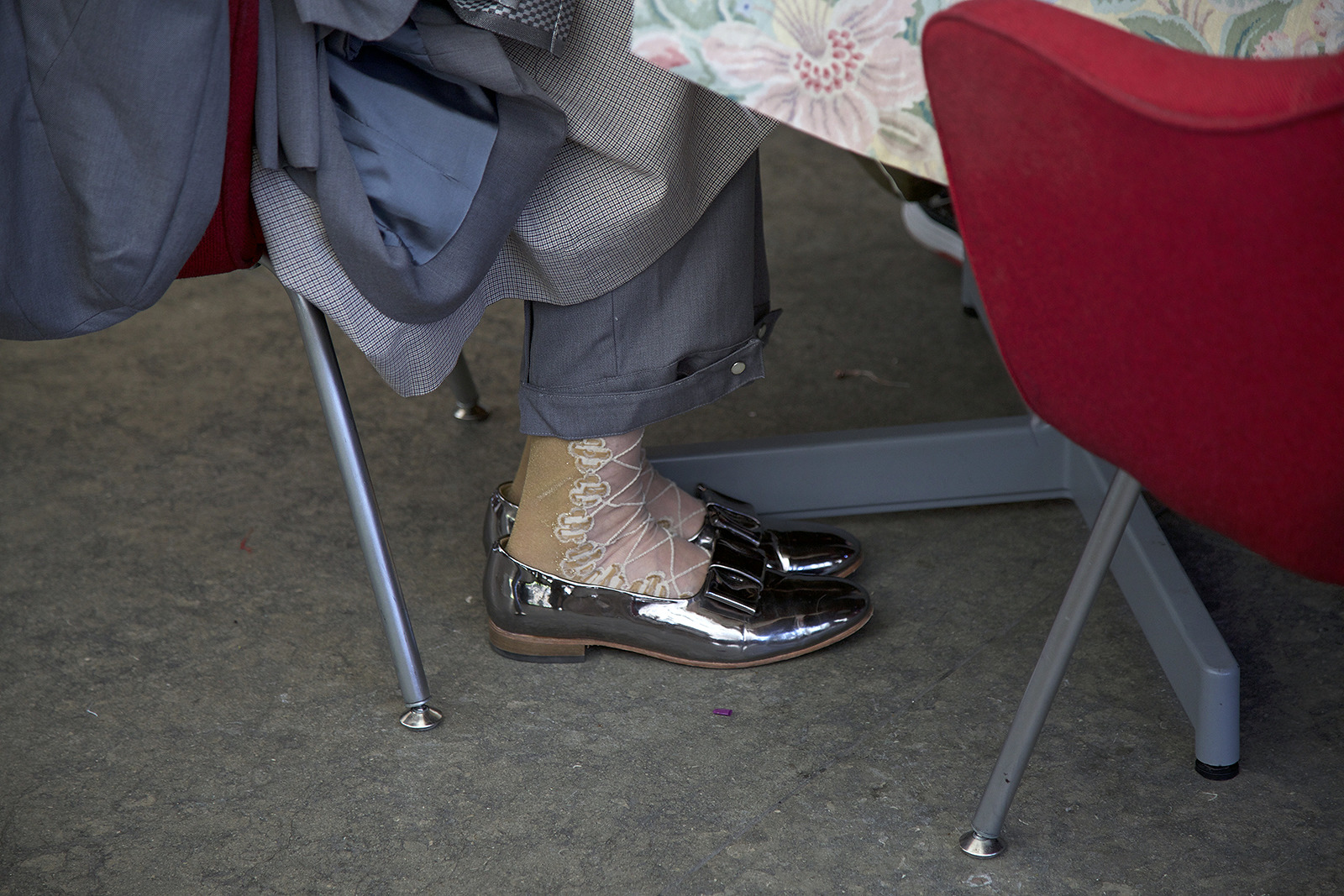
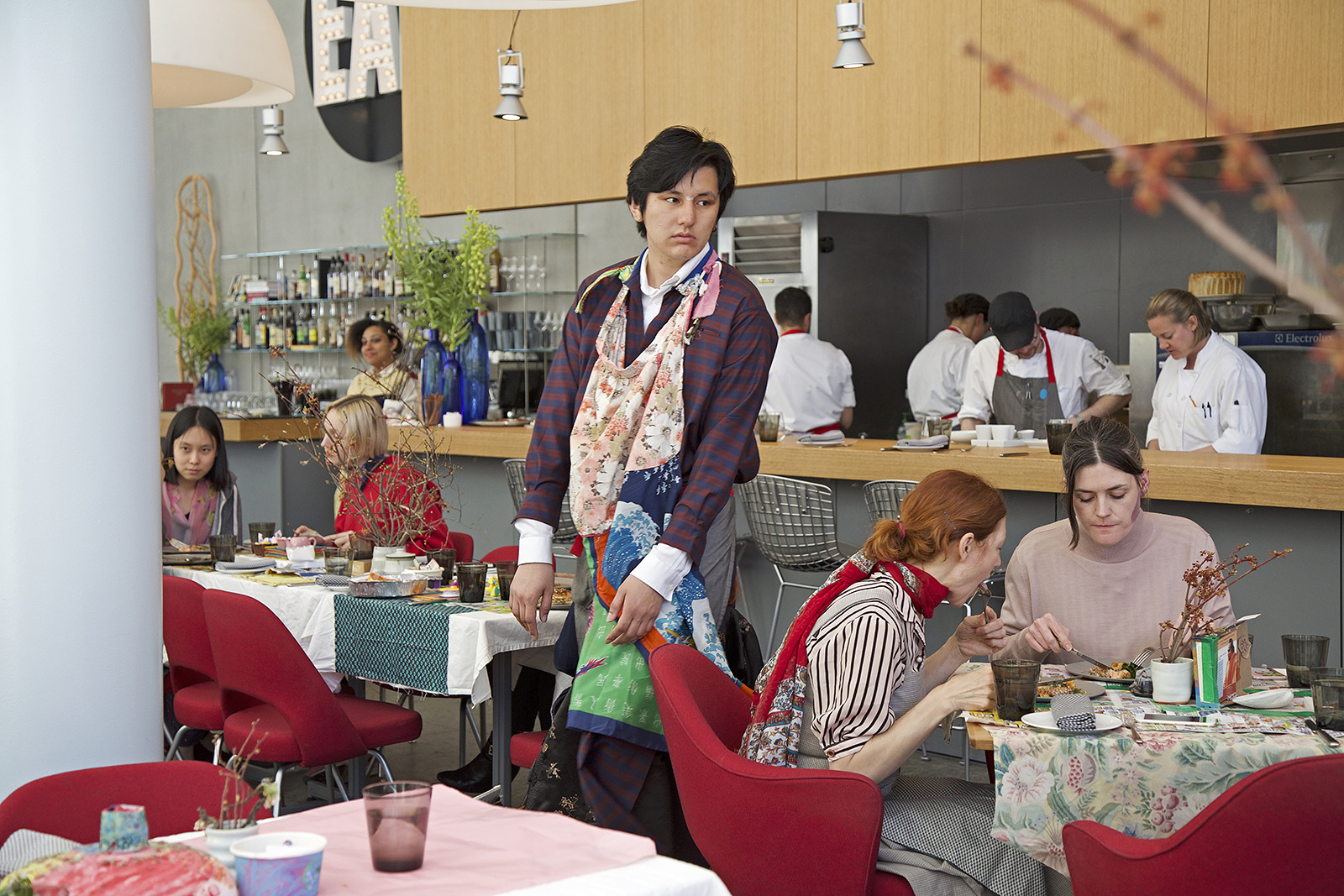
HL: I wanted to ask you because this is maybe a naive question. I remember you from the mid-90s as a designer. I remember when we first met….
SC: I remember you as a stylist. Are you still. Are you working as a writer or as both?
HL: About 3 years ago I knew that I needed to make a transition. I’m more into consulting now. I consult with brands, publications and institutions. I guess I’ve moved into “creative direction”? I style less and less now. I’ll do it for projects that I’m really invested in, but by trade or as a job, well it’s something that…you evolve and grow and figure out what you love about something. And, what you’d like to leave behind. I grew up around clothes and fashion so it’s always close to me.
SC: I know exactly what you mean. It’s why I switched from being a designer. But you know when it happens, you’re still the same person. I knew a long time ago and I knew it would take a long time the transition (from Fashion). I was aware of the process and when I would finally get from A to Z and how patient I had to be. It was a like a feeling and I would try to explain it to people that were close to me but they didn’t really understand. I had to say it over and over again to stay on course. Now there is a sense of freedom where I can let it go, now I can really feel relief that I am just “whoever” and I can really let my guard down. I remind myself that everything is a learning experience..I find it really great that I have been able to learn so much, and this is just the beginning. I could not have done this before. I have so much integrity that I will not ever settle. It took a lot to get here.
SC: So, we just moved and I still had some of the early press in magazines from ‘95- I came across one of my most favorite images, and it was in was Spin– and you styled it. I kept that one because it was honestly one of my most favorite images. I just pulled it out and I posted it recently. And then they said your name for this interview…those are the kinds of signs when things are in the right direction.
HL: Thank you, that means so much to me.
SC: Wait, Were you a stylist on a trip that I took with Frankie [Rayder]?
HL: Ha, to Tulum. Yes, I remember you were there. That’s right. I had completely forgotten. It was a trip for Arena Homme Plus. I recently remembered this when I knew we were meeting, and was trying to put all the pieces together. And, I remembered I did something once with Chloe [Sevigny] and you did this collection with older women who hand knit some pieces that I pulled from your studio in Chinatown at the time.
SC: It was my mom and my grandmother did those. It was more all of my friends’ mothers and grandmothers agreed to help because I was so so desperate that it was so much work.
HL: But they were so beautiful. That was such a beautiful shoot.
SC: I don’t like to go back and say, I love the 90s, but that reminds me how much I miss it. Because that was so real. That kind of styling and that kind of time and that kind of feeling. I know everyone’s trying to capture it again, and they ask me 100 questions about it, and I don’t know, but when I look at it, it brings me back, and I can’t put it into words. But you were there and you did it, so you understand what I’m talking about.
HL: The difference was people were doing things for the sake of doing them. No one was trying to be famous. That was not the goal.
SC: There was no trying of anything. A lot of people getting together and experimenting.
HL: A generation of people who just thought, “Ok, this is what feels right right now.”
SC: It was so fluid. There was such an overlap of people doing things and it was in sync.
HL: So much work that has come from that time, still really holds up today. I think because it’s honest.
SC: It’s honest. That’s the bottom line. That’s the key point to it all. That is the answer for everything.
